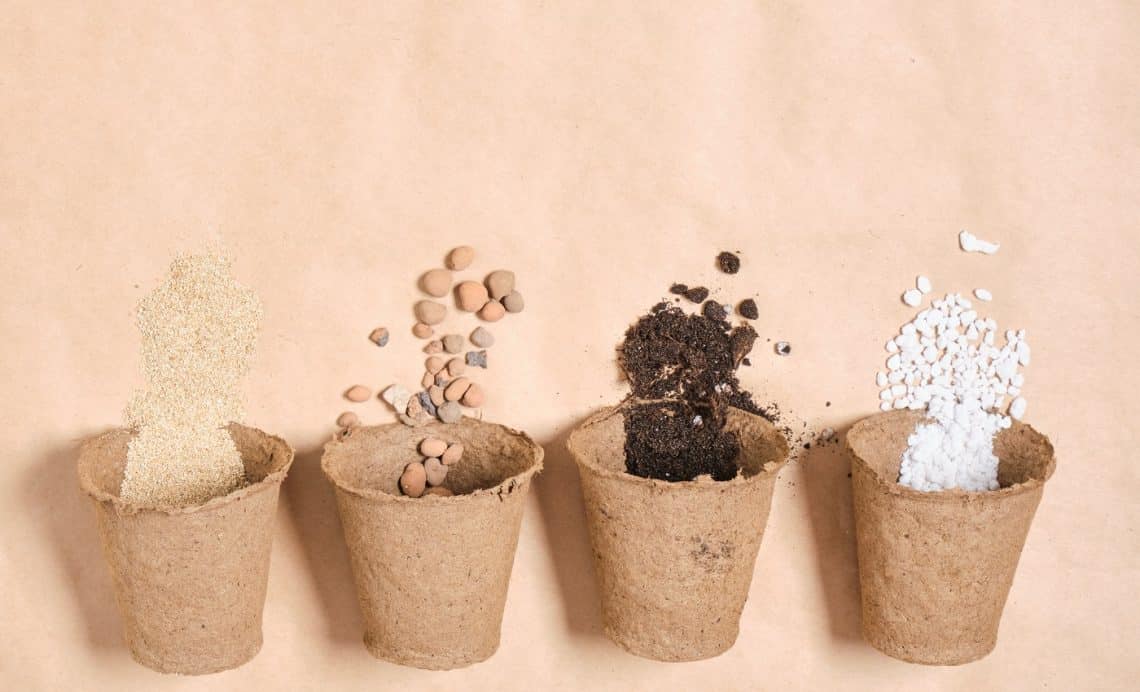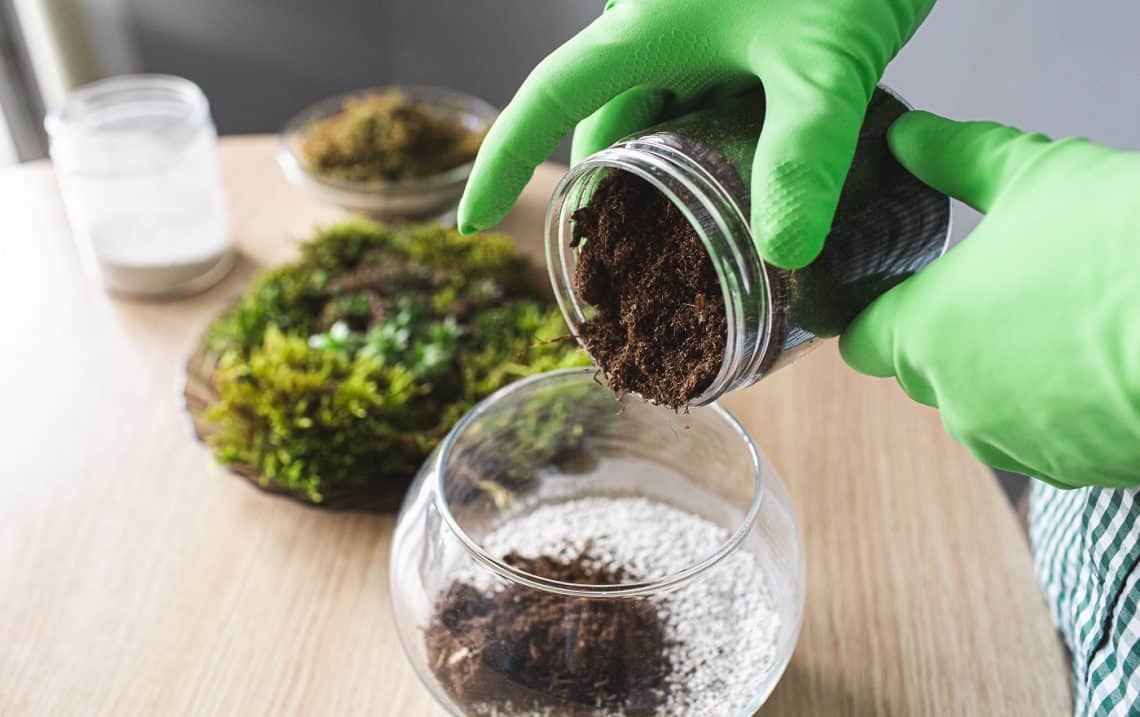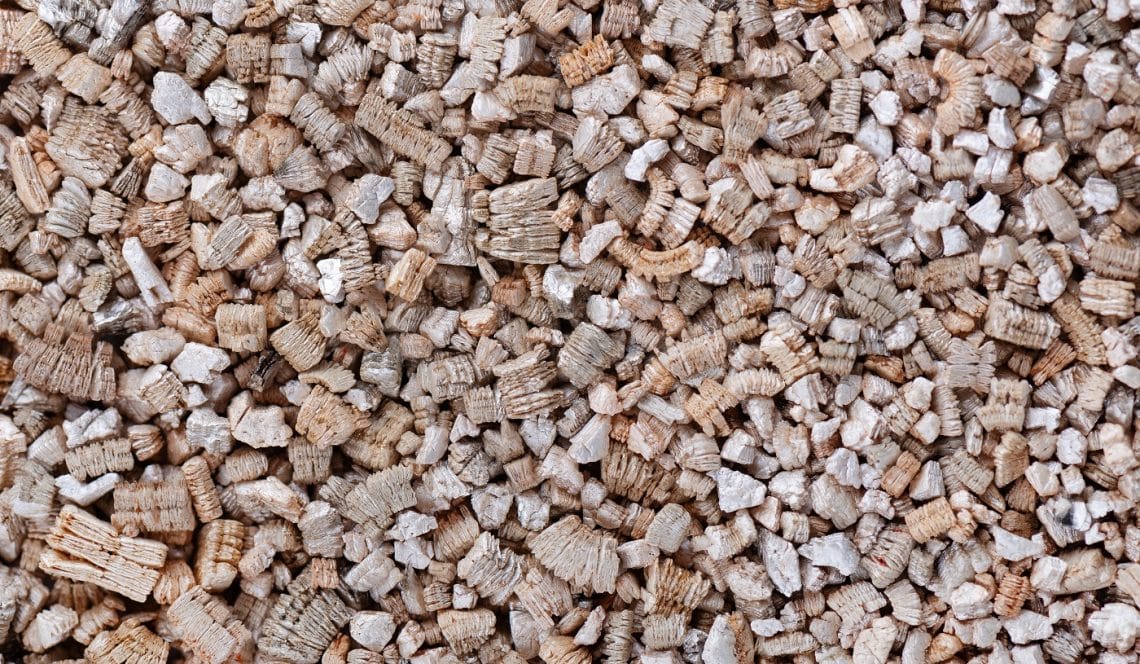Perlite and Vermiculite are common additives that enhance the quality of soil. But there’s quite a lot of confusion in the gardening community about these.
Why? Because both of these soil additives are pretty similar in use as they maintain and repair soil structure. Hence, the soil can grasp plants firmly and enrich them easily with nutrients. And all of that is made possible due to a boost in soil health by adding minerals.
Furthermore, soil additives such as Perlite and Vermiculite can be used for insulation, drainage, and root growth. That being said, how do you pick one of these two alternatives?
- ✅ BEST GROWING MEDIUM for Plants Grown in...
- 🌟 IMPROVED AERATION of SOIL — Porosity of...
- 🏺 PERFECT FOR POTTED PLANTS — Indoors and...
- 💞 NATURAL CONDITIONER — Reacts With Soil To...
Note the differences between the two soil additives by going through this comprehensive guide that we have carefully curated for you. We’ll also address the best way to use each of these additives to derive optimal results.
So, without further ado, let’s get started, shall we?
How To Use Perlite & Vermiculite For The Garden
![What Is Perlite, Vermiculite [Differences, Guide &Amp; How To Use Them] 32 Close-up of hands in gloves pour peat into the florarium](https://dev.architecturelab.net/wp-content/uploads/2021/07/What-is-Perlite-Vermiculite-02-557x350.jpg)
Natural minerals such as Perlite and Vermiculite are similar in their use of maintaining soil health. Sometimes, you might have noticed a styrofoam ball-like substance dotting the soil in the pot that you have just bought.
These small balls most likely could be Perlite, spread out throughout the surface of the soil. Both Vermiculite and Perlite are natural minerals found in garden beds, potted plants, seeded plants, and containers with plants and raised beds.
There are some more similarities between Perlite and Vermiculite that we shall briefly touch upon here.
Similarities Between Perlite And Vermiculite
The pH levels of both Perlite and Vermiculite range between 7.0 and 7.5. Both do not decompose into the soil they are mixed with, and can see them on the ground’s surface. It can easily be said that there is no need to compare Perlite and Vermiculite when it comes to planting new seeds and preparing the soil.
Both are considered ideal for potting mixes and seed starting, and you can take your pick according to the garden’s requirements. These natural minerals are also approved for organic gardening.
Also, Perlite and Vermiculite are known to improve drainage and help the soil in retaining moisture. However, that is where the critical difference also lies between the two. It has been found that they have different abilities in moisture retention, and this is to your advantage. You can use both natural minerals in various ways to treat the garden well.
Let us now look at the natural mineral that is more commonly used before going on to more important details. Perlite is a soil additive that you should be familiar with if you are raising plants.
Perlite
Have you heard of the term “volcanic popcorn?” It is the nickname for Perlite that is made by giving excessive heat to volcanic glass. The entire process is carried out at extremely high temperatures.
Once the volcanic glass increases in volume and takes the shape of a white ball-like substance that looks very similar to Styrofoam, the process is complete. You will see the volcanic glass pop into lightweight balls. These small, porous, and lightweight balls look like tiny white rocks.
Also, Perlite has a unique hollow, cave-like structure that lets water flow easily. It can primarily be used to drain water out to maintain the plants. Interestingly, Perlite allows moisture to be retained in the soil and can also absorb nutrients to store them for the plants.
It may seem like an extraordinary characteristic to drain water and retain moisture simultaneously, but this is what helps make Perlite a good oxygen provider. Not only that, it is this feature of Perlite that makes it helpful in improving soil structure.
Vermiculite
The scientific name of Vermiculite is derived from its components and structure. Vermiculite is a group of hydrated minerals known as phyllosilicates. The composition of phyllosilicates is iron aluminum magnesium silicate.
Phyllosilicates flakes share a range of colors from grayish brown to silvery gold – this is a good way of identifying Vermiculite. The mineral is abundantly found in nature and, like Perlite, expands when heated.
The heating process is also known as exfoliation. During the process, Vermiculite expands many times the original volume to acquire a rough shape and size. The transformation from flakes that are crude in appearance to a hexagonal granule that looks like a pebble is interesting to see.
Moving on, the granules are then processed further to produce low, medium, and high-quality Vermiculite. The mineral has special energy-saving and insulating properties that make it popular for industrial and commercial use.
Also, Vermiculite has specific properties such as lightness in weight, sterility, non-combustibility, and non-reactivity to everything except powerful acids. It is an inert material that does not respond very quickly to other materials.
Being non-toxic, Vermiculite is safe to use and is used mainly at home, in the garden, and construction. Its various applications include insulation, fire protection, potting soils or potting mixes, concrete and plaster screeds, packaging and special coatings, and lining swimming pools.
Vermiculite comes in four grades for use in horticulture. Grade 1 is fine, Grade 2 is medium, Grade 3 is coarse, and Grade 4 is super coarse. The grades range from 1mm to 8mm.
Is Vermiculite Harmful?
Vermiculite that is available in stores is safe to use. It does not contain asbestos, as is sometimes claimed. It is, however, suggested that you wear a dust mask while handling Vermiculite because it has fine particles. These are not harmful to the garden but may accidentally cause discomfort to you while the additive is being used.
Due to its antecedents, it is feared that Vermiculite may still contain asbestos as it once had when mined from a particular place in the US. However, makers and sellers of the soil additive are cautious about its composition.
- ✅ BEST GROWING MEDIUM for Plants Grown in...
- 🌟 IMPROVED AERATION of SOIL — Porosity of...
- 🏺 PERFECT FOR POTTED PLANTS — Indoors and...
- 💞 NATURAL CONDITIONER — Reacts With Soil To...
Perlite vs. Vermiculite
Both Perlite and Vermiculite serve as conditioners of the soil and are used for gardening. Perlite can also provide drainage, loosen dirt that is tightly packed, and hold 3-4 times its weight in water.
But, this is where the similarities between Perlite and Vermiculite end. Vermiculite has a better capacity for holding water as a planting medium. That is because Vermiculite is a compact medium; it cannot be compressed as much as Perlite.
On the other hand, Perlite has a higher capacity to hold water on the surface of all the edges and hollows it has. That makes Perlite lose moisture quickly. Such a characteristic can also be used to the advantage of soil health in the garden.
Calculating the amount of Perlite required for the soil can help decide the balance of water and moisture you need for the plant. Choose Vermiculite if you have starting seeds to plant in the garden and Perlite if there is heavy soil to be loosened.
Clay soil is a good example of heavy soil that can be treated easily by Perlite. Starting seeds need moisture in the soil for nourishment during the early stages of germination. Perlite can break down crusts on the surface and loosen tightly-packed soil.
Other Differences Between Perlite And Vermiculite
Vermiculite is suitable for outdoor plants that tend to dry quickly due to constant exposure to heat and wind. Plants kept in fabric pots, or terra cotta would dry even faster due to the material of the pots. Both the fabric and terra cotta pots are porous that makes them lose moisture quickly.
Adding Vermiculite to the potting mix can save the moisture in the plant and keep it nourished and secure. In contrast, Perlite is excellent for plants that are kept indoors and need less water.
So, plants that can be kept in the shade, all kinds of cacti, and succulents that can stay fresh for hours without watering can benefit from a potting mix blended with Perlite. The soil additive also helps in preventing fungal diseases and the rotting of roots.
If you live in a place that sees frequent dry weather, using Vermiculite for potting mixes prevents moisture erosion in the soil. Perlite, as you may have guessed by now, is better for humid and wet climates.
Adding a little Perlite can go a long way in preventing water logging in gardens, pots, and containers. Mostly, remember that the rule is to use Perlite when aeration and drainage are required. Vermiculite is best used for the retention of moisture in the soil.
Informational Guide
Watching over that beloved garden bed and your favorite potted plants seems much easier with the use of the soil additives. Apart from having complete control over water and moisture balances in the soil, both Perlite and Vermiculite can be used to prevent damage and disease to plant growth.
-
Safety
Both soil additives being discussed here have a disadvantage. Perlite and Vermiculite produce dust that, in the long run, can hurt the lungs. The dust has been categorized as ‘nuisance dust’ by the Occupational Safety and Health Administration (OSHA).
That essentially means the dust is not harmful but can cause diseases if inhaled for a long time. Handling significant quantities of Perlite and Vermiculite requires that you wear a bandana around the nose and mouth.
Either that or, as suggested earlier, wear a dust mask to prevent respiratory diseases, sensitivity to dust, and unnecessary irritation.
-
Organic Minerals
Perlite has been certified as an organic material by the United States Department of Agriculture (USDA). For a mineral to be classified as an organic material, it should have come from the ground with limited or no processing.
Perlite fits this classification perfectly and is a categorized organic material. Vermiculite, too, is obtained as a natural material and processed in garden soil.
-
Gardening Essentials
We all know that to grow plants, whether in a garden bed or in pots to decorate the house, a few essentials are required to keep the plants healthy and secure. Sunlight, water, soil, manure, fertilizers, tending, and weeding are factors and processes that go into the growth and maintenance of plants.
Natural minerals like Perlite and Vermiculite are soil additives that control moisture, drainage of water, insulation, root health, and prevent diseases in plant soil. They are essential not just for the expert gardener but also for a plant lover, like you perhaps, to maintain the house.
So, for example, once the starting seeds have been patted into the garden bed and the old plants prepared for repotting, use these two additives to keep the soil structure maintained. That will provide the plant with the support they need from the soil.
We would suggest that you treat Perlite and Vermiculite as gardening essentials and get used to applying them in your gardening routine.
-
Availability
Both Perlite and Vermiculite are readily available online due to their low density. The soil additives can also be purchased at garden centers, where it is easier to see and examine the products before buying them.
There might be someone at the garden center who can help you understand both the additives better. That is a bonus for having made an effort to go to a center for your garden shopping.
- ✅ BEST GROWING MEDIUM for Plants Grown in...
- 🌟 IMPROVED AERATION of SOIL — Porosity of...
- 🏺 PERFECT FOR POTTED PLANTS — Indoors and...
- 💞 NATURAL CONDITIONER — Reacts With Soil To...
How To Use Perlite And Vermiculite
Perlite can be mixed with soil in proportions to give the exact results that you are looking for in the earth. Essentially, 10% to 20% of Perlite mixed in the soil is enough to perform its main functions and keep the soil healthy.
These include aeration, drainage of water, and soil structure maintenance, amongst other functions. Perlite makes an excellent combination with Vermiculite for maintaining perfect soil structure.
As we have learned, Vermiculite is like a sponge that can hold onto moisture. Mixing the two in your starting seed or potting mix can give just the right balance of water drainage and moisture retention for the soil to keep healthy.
Which One To Use: Perlite Or Vermiculite?
Quite often, drainage and aeration are the two aspects of gardening that go unnoticed by many people who garden or grow potted plants in their homes. Only after some familiarity with plants do people pay attention to the quality of soil as well.
And, it is these two aspects that a simple additive like Perlite can handle. That too, just by mixing it in the soil in the correct proportion. But, people tend to overlook the fact that the usage, absorption, and drainage of water also affect how rich the soil is of moisture content.
That is especially true of soil beds that have just been planted with starting seeds. Seeds need moisture for nourishment and can leave you in dismay if you don’t understand why the seeds are dry even after watering the soil.
Add Vermiculite to the seedbed to solve this problem in a jiffy. Create a nice mix of Perlite and Vermiculite to create a healthy and balanced soil structure for the growth and maintenance of the garden.
![What Is Perlite, Vermiculite [Differences, Guide &Amp; How To Use Them] 49 Vermiculite background. Exfoliated perlite and vermiculite texture background. Mineral used in gardening](https://dev.architecturelab.net/wp-content/uploads/2021/07/What-is-Perlite-Vermiculite-03-601x350.jpg)
Final Words
Remember, some plants may grow well in acidic soil, while others can take root only in alkaline soil. Knowing the combination of Perlite and Vermiculite that can best suit different soil types would be a boon for your gardening skills.
You can easily expect the plants to flourish with the expertise you can bring in with the knowledge of these two soil additives. That is because they can repair and maintain the soil structure, which is essential to the plant’s life.
Hope that you had a meaningful read today with this informational guide on Perlite and Vermiculite. Happy gardening!
Related Articles
What is Rockwool & Rockwool Cubes [Using Rockwool in Hydroponics]
Hydroponic Wick System Garden 101 [Guide & Tips]
How Fast Do Succulents Grow [How to Grow Succulents Faster]
Coconut Coir [What Is Coco Coir & How To Use It In Hydroponics]
Peat Moss at Home 101 – Sphagnum Peat Moss Uses Today
Dwarf Umbrella Tree 101 – Care and Growth of Schefflera Arboricola
13 Best Fertilizer for Hydrangeas
What Is A Linear Foot | Architect’s Information
What Is A Veranda | All You Need To Know
What Is A Pony Wall? | Things To Know
What Is Rain Glass? | Thing You Should Know
What Is Pewter? | All You Need To Know
- ✅ BEST GROWING MEDIUM for Plants Grown in...
- 🌟 IMPROVED AERATION of SOIL — Porosity of...
- 🏺 PERFECT FOR POTTED PLANTS — Indoors and...
- 💞 NATURAL CONDITIONER — Reacts With Soil To...






![What Is Perlite, Vermiculite [Differences, Guide &Amp; How To Use Them] 1 Several peat pots with different ingredients for preparing fertile soil for plants, stones for drainage, perlite, soil for seedlings, fertilizer for the garden](https://dev.architecturelab.net/wp-content/uploads/2021/07/What-is-Perlite-Vermiculite-01.jpg)
![What Is Perlite, Vermiculite [Differences, Guide &Amp; How To Use Them] 28 Organic perlite by perfect plants — add to soil for indoor & outdoor...](https://m.media-amazon.com/images/I/41RBhG2o1AL.jpg)
![What Is Perlite, Vermiculite [Differences, Guide &Amp; How To Use Them] 30 Organic vermiculite by perfect plants - 8 dry quarts natural medium...](https://m.media-amazon.com/images/I/41oxFTBEsXL.jpg)
![What Is Perlite, Vermiculite [Differences, Guide &Amp; How To Use Them] 33 5146usuptll. Sl500](https://m.media-amazon.com/images/I/5146UsuPtlL._SL500_.jpg)
![What Is Perlite, Vermiculite [Differences, Guide &Amp; How To Use Them] 34 51ywwh4qg5l. Sl500](https://m.media-amazon.com/images/I/51ywwh4QG5L._SL500_.jpg)
![What Is Perlite, Vermiculite [Differences, Guide &Amp; How To Use Them] 35 416mginkygl. Sl500](https://m.media-amazon.com/images/I/416mgiNkYgL._SL500_.jpg)
![What Is Perlite, Vermiculite [Differences, Guide &Amp; How To Use Them] 36 515fnq5bn2l. Sl500](https://m.media-amazon.com/images/I/515fnq5bN2L._SL500_.jpg)
![What Is Perlite, Vermiculite [Differences, Guide &Amp; How To Use Them] 41 51twqxau1sl. Sl500](https://m.media-amazon.com/images/I/51TwQXau1SL._SL500_.jpg)
![What Is Perlite, Vermiculite [Differences, Guide &Amp; How To Use Them] 42 41st34wa0rl. Sl500](https://m.media-amazon.com/images/I/41ST34WA0rL._SL500_.jpg)
![What Is Perlite, Vermiculite [Differences, Guide &Amp; How To Use Them] 43 51vav2nvm7l. Sl500](https://m.media-amazon.com/images/I/51vav2nVm7L._SL500_.jpg)
![What Is Perlite, Vermiculite [Differences, Guide &Amp; How To Use Them] 44 518wh+uhmbl. Sl500](https://m.media-amazon.com/images/I/518Wh+UHMBL._SL500_.jpg)